Optimized Segmentation of the Crystal River Unit 3 Reactor

AUTHORS
Sebastien Guillot, Matt Lucas, Dirk Bender
Orano Decommissioning Services, LLC
PRESENTED
March 1, 2023
ABSTRACT
Orano DS patented and is implementing at the Crystal River Unit 3 (CR3) accelerated decommissioning project in Florida an innovative approach to the dismantling of commercial and research nuclear reactors. The patented 1 Optimized Segmentation process aims to reduce the volume of waste for disposal and the amount of segmentation work on the reactor structures, with substantial benefits in overall execution schedule, dose, and cost.
At CR3, Optimized Segmentation avoids entirely the time-consuming segmentation and packaging into standardized waste containers (and their numerous waste shipments) of all non-GTCC-rated internals and the reactor vessel.
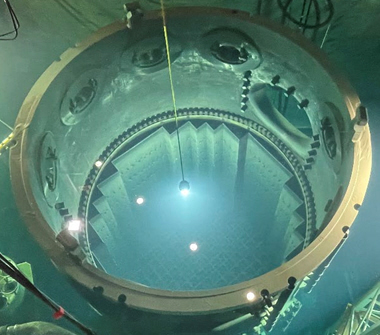 The Optimized Segmentation process first segments, extracts and separates underwater all of the reactor internals into two categories:
1.) Greater-than-Class C (GTCC) waste to be handled, packaged, and stored using conventional methods (e.g.,
NUHOMS® systems); and 2.) highly
contaminated and activated internal structures.
The Optimized Segmentation process first segments, extracts and separates underwater all of the reactor internals into two categories:
1.) Greater-than-Class C (GTCC) waste to be handled, packaged, and stored using conventional methods (e.g.,
NUHOMS® systems); and 2.) highly
contaminated and activated internal structures.
The now-empty reactor vessel is repacked underwater using a precisely engineered placement of the highly contaminated and activated waste based on each piece’s characterization. This concentrates the highest waste category components in the middle of the vertical vessel, while less activated waste is placed in the bottom and top sections. The reactor vessel and repackaged internals are then drained and immobilized in grout specifically prepared to achieve the ALARA goal and to immobilize the reactor internals inside the vessel.
The solid, grout-filled reactor vessel packed with waste is subsequently segmented into three large sections (bottom, middle, top), consistent with the optimized waste distribution. Each section is packaged and shipped individually in a tailor-made container designed to safely transport and dispose of the waste in compliance with relevant regulations (NRC for Type B shipment, DOT for Industrial Package), and the disposal site’s Waste Acceptance Criteria.
Of the three segmented reactor vessel sections, only the middle section requires an NRC-approved Type B package for shipment in accordance with 10 CFR Part 71. The design of this Type B package was completed in August of 2021, and the license application is being reviewed by the NRC. The optimized waste characteristics in the two remaining reactor vessel segments – the bottom and top sections – will only require shipping containers to comply with the DOT Industrial Package regulations (49 CFR 173).
Reactor dismantling operations started at CR3 in 2021. Components of the reactor cooling system (Steam Generators, Main Coolant Pumps & Motors, the Pressurizer, and Large Bore Piping) have been removed from the containment building and shipped off-site for disposal. Segmentation of the reactor internals at CR3 commenced and were completed in 2022 and removal of all reactor structures from the containment building will be completed in 2023.
1 Orano DS holds U.S. patents (US 9,728,287 and US 9,984,780) for a method of decommissioning a nuclear reactor that is referred in this publication as “Optimized Segmentation”.
Orano DS LLC (ODS) and TN Americas (TN), as two of Orano USA’s business units, provide expertise throughout the entire decommissioning process for U.S. facilities, including planning, engineering, project management, used fuel transfer from wet to dry storage, decontamination, dismantling, waste packaging and transport, ISFSI management, used fuel transport offsite, and site restoration.
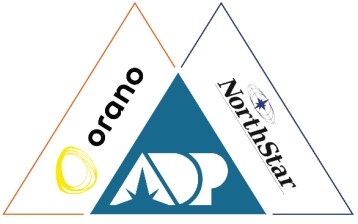 Accelerated Decommissioning Partners (ADP) is a joint venture formed in 2017 between NorthStar Group Services, the
largest demolition company in the world, and Orano USA. ADP delivers a unique offer adapted to best fit the needs of shutdown reactor owners and provides an accelerated turnkey solution that completes the Nuclear Regulatory Commission license termination
process for a fixed price on a guaranteed schedule.
Accelerated Decommissioning Partners (ADP) is a joint venture formed in 2017 between NorthStar Group Services, the
largest demolition company in the world, and Orano USA. ADP delivers a unique offer adapted to best fit the needs of shutdown reactor owners and provides an accelerated turnkey solution that completes the Nuclear Regulatory Commission license termination
process for a fixed price on a guaranteed schedule.
The ADP member companies, NorthStar and Orano, are performing the decommissioning of Vermont Yankee (VY), which was also the industry’s first complete and permanent license transfer of a shutdown reactor from a utility to a private entity, NorthStar, for decommissioning. As the leading global demolition company and now as the VY site owner, NorthStar is efficiently managing and performing the complex requirements of a safe, efficient, and compliant accelerated decommissioning project. As a subcontractor on the NorthStar team, Orano applied its global expertise to segment and package the reactor vessel and its internal structures, and safely transport some of the highest activity components to the disposal site in Texas. Orano completed the segmentation and disposal of the reactor and its internal components in August 2022, less than five years after the accelerated decommissioning began, with no safety or regulatory issues.
 On Oct. 1, 2020, Accelerated Decommissioning Partners and Duke Energy completed a transaction to begin decontamination and dismantlement of the Crystal River Nuclear Plant (CR3) in Citrus County, Fla., in 2020 instead of 2067
– nearly 50 years sooner than originally planned. Accelerated Decommissioning Partners became the Nuclear Regulatory Commission-licensed operator responsible for decommissioning the plant, and acquired the used nuclear fuel and the ISFSI assets
where it is stored, in compliance with all state and federal regulations.
On Oct. 1, 2020, Accelerated Decommissioning Partners and Duke Energy completed a transaction to begin decontamination and dismantlement of the Crystal River Nuclear Plant (CR3) in Citrus County, Fla., in 2020 instead of 2067
– nearly 50 years sooner than originally planned. Accelerated Decommissioning Partners became the Nuclear Regulatory Commission-licensed operator responsible for decommissioning the plant, and acquired the used nuclear fuel and the ISFSI assets
where it is stored, in compliance with all state and federal regulations.
ODS supports the CR3 work focusing on the dismantlement of the Reactor Cooling System, Vessel, and Vessel Internals.
After just one year, all major components of the Reactor Cooling System have been removed, packaged, shipped off-site by rail, and disposed of at the Waste Control Specialist waste disposal facility in Andrews, Texas. At the same time, ADP CR3 and ODS had reconfigured the CR3 Reactor Building and completed preparations to begin the disassembly and dismantlement of the reactor components.
The main drivers in the cost and schedule of a reactor D&D operation are typically the extent of segmentation work to be performed on the reactor component and the number, size, and classification of the waste packages generated by the dismantling process.
The most contaminated and activated components of a nuclear energy reactor are concentrated inside the reactor vessel (RV) and vessel internal structures (RVI). The dismantlement of the RV and RVI structures generates the waste with the highest classifications: A, B, C, and Greater-than-Class C (GTCC), and the highest cost for packaging, transportation, and ultimately disposal.
Optimizing cost involves being able to segregate and distribute the generated waste within the various classifications in an effort to minimize the volume of the most costly portion of the waste: GTCC and Class B/C.
The art of planning the segmentation and packaging of the RV and RVI waste involves finding the ideal compromise working within the following constraints:
One solution to this challenge is the “one piece” approach, where the entire reactor vessel is shipped, including some of the reactor vessel internals. This solution has been successfully implemented in previous reactor D&D projects (Trojan, Yankee Rowe, Songs Unit 1), but involves very large packages and conveyance systems, which will be constrained by the limitations of the available transportation route infrastructure (roads and bridges capacities, clearance limitations from other overhead structures such as bridges, tunnels, power lines, etc.).
The waste generated during the D&D of CR3 is being shipped from Florida to Texas and disposed of at the Waste Control Specialists (WCS) facility in Andrews, TX. The location of CR3 offers access to transportation by road, rail, and barge through the Gulf of Mexico. The barging option offers the opportunity to ship large containers all the way to Texas, but the transit from the coast of Texas to the WCS facility still imposes the limitations of a long road and/or rail transportation. ODS, with support from its transportation logistics sister division TN Americas, conducted a route survey to determine that a combination of barging and road transportation offered the opportunity to ship packages as large as 18 feet high, 20 feet wide, and with a load of up to 450 Metric Tons without necessitating temporary cost-prohibitive road infrastructure modifications.
This envelope formed the basis of the Optimized Segmentation strategy implemented for CR3.
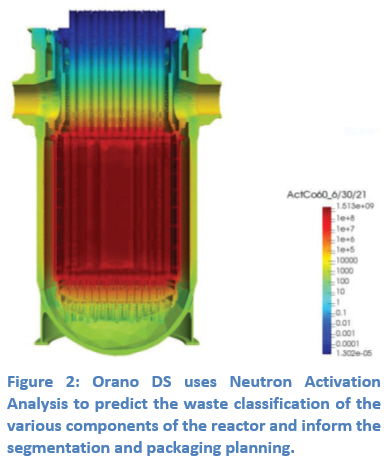 The Crystal River Unit 3 nuclear power plant is a Babcock and Wilcox Pressurized Water Reactor which operated for more than 40 years before ceasing operations in 2009.
The Crystal River Unit 3 nuclear power plant is a Babcock and Wilcox Pressurized Water Reactor which operated for more than 40 years before ceasing operations in 2009.
ODS modeled the operating history of the reactor, calculated and analyzed how the various components of the reactor had been irradiated and activated, and, using survey data, was able to predict the expected waste classification of each part of the reactor vessel and internals.
The CR3 RV/RVI Greater-than-Class C components are located in the core region internals and consist of the core barrel assembly, the surveillance capsule holders, surveillance capsule dosimeters, and in-core instrument detectors. These components were separated and segregated from the rest of the RV/RVI components and packaged in containers to be transferred and stored on site within the existing CR3 Independent Spent Fuel Storage Installation (ISFSI).
The CR3 RV/RVI Class B/C components are located in the other areas closest to the core region and consist of the control rod guide tube assemblies, upper core grid, the thermal shield, and lower internals assembly.
The CR3 Class A and B/C will be segmented and packaged for off-site shipment and disposal at the WCS disposal facility using the Optimized Segmentation approach.
The CR3 RV/RVI Class A components are the balance of RV/RVI components, the plenum cover, plenum cylinder, core support shield assembly, reactor vessel, and vessel head.
3.2 CR3 segmentation and packaging strategy
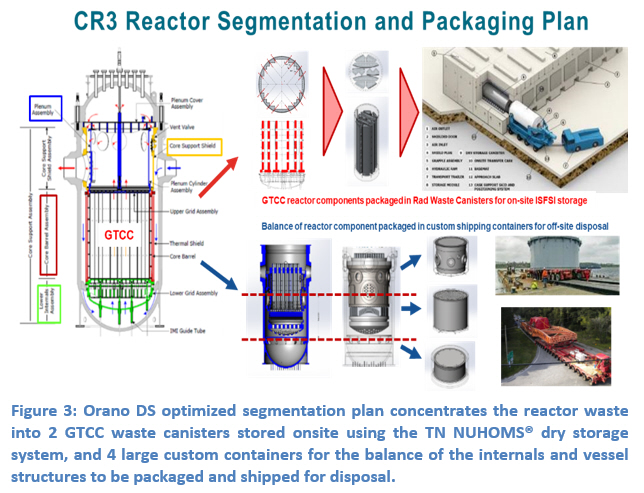 The shipping container envelope set as the basis for packaging the CR3 Class A, B and C waste offers the possibility
to package the entire vessel and internals in three segments or slices, using the vessel as a primary shell, along with handling the reactor head separately as one piece.
The shipping container envelope set as the basis for packaging the CR3 Class A, B and C waste offers the possibility
to package the entire vessel and internals in three segments or slices, using the vessel as a primary shell, along with handling the reactor head separately as one piece.
Once the GTCC portion of the internals has been extracted, the balance of the internal structures are separated, segregated, recombined, and positioned inside the vessel. The segmentation and segregation plan of the internals enables the concentration of the Class B and C components within the volume of one large shipping container, created out of the middle section of the vessel, with both the remaining top and bottom sections containing only Class A waste.
Once the internal structure segments have been recombined inside the vessel, a specifically engineered grout is used to immobilize the various components and diamond wire sawing is used to separate the vessel monolith into three horizontal sections.
3.3 CR3 segmentation and packaging process and technologies
3.3.1 Reactor Vessel Closure Head
The CR3 reactor head is a Class A component which will be handled, packaged, shipped, and disposed of as one piece, once the control rod drive mechanisms and service structure have been removed. Because of its very low level of activation and contamination, the reactor head was packaged into a custom-designed super sack.
3.3.2 CR3 GTCC waste segregation, packaging, and onsite storage
The GTCC portion of the reactor vessel internals is located on the Core Support Assembly (CSA).
First the plenum assembly is unloaded from the vessel and its top portion is modified so it can be reloaded later inside the vessel at a lower altitude without hanging from the vessel top flange.
The CSA will be unloaded from the reactor vessel and transferred into the deep end of the Fuel Transfer Canal where a segmentation workstation has been setup. The main segmentation technology selected for this application is the Water Abrasive Suspension System (WASS).
The WASS technology offers the ability to perform precise, remotely controlled cuts through several inches of the combination of steel/water/steel, as encountered on the core barrel and core baffle plates assembly, thus minimizing the number of cuts and segments to be handled.
WASS is first used to modify and separate the core support shield from the rest of the CSA and remove the thermal shield in several segments. The core barrel assembly (core barrel, former plates, and baffle plates) is then segmented in 16 vertical strips, sized to fit into two TN NUHOMS® Rad Waste Canisters (RWC).
The two RWCs are then closed, sealed by welding, and transferred for onsite storage on the existing CR3 ISFSI, using the TN Americas’ OS-197 transfer cask system.

3.3.3 Consolidation of the non-GTCC waste inside the reactor vessel
The remaining bottom section of the core support assembly, including the lower grid and flow distribution structures, is repositioned inside the reactor vessel as one piece without any additional segmentation work.
The segments of the thermal shield are loaded inside the vessel and positioned on top of the lower internals. These segments include the surveillance specimen holder tubes. The tightly packed pieces in the lower section prevent the highly activated components in the middle from sliding down into the lower section before grouting.
The plenum assembly, including all the control rod guide tubes, is loaded back into the core support shield. Both components are then positioned in the upper section of the vessel on top of the lower core assembly and thermal shield segments. The overall altitude/vertical position of these stacked RVI structures is set such that the Class B and C components are located in the middle section of the reactor vessel. This completes the underwater portion of the segmentation work and the fuel transfer canal and vessel can now be drained down.
The segments of the internals positioned inside the vessel are immobilized in engineered grout through several successive placements. Once the grout has solidified, the vessel nozzles are severed so that the vessel is separated from the reactor cooling system piping. Then, the vessel insulation is removed.
3.3.4 Segmentation, packaging, and off-site shipment of the vessel and internals
Diamond wire sawing will be used to perform controlled horizontal cuts through the section of the vessel and grouted internal structures to separate the vessel monolith into three horizontal slices sized to fit within the dimensional and weight constraints of the transport packages.
A heavy lifting and rigging system will be setup inside the containment building to complement the limited load capacity of the CR3 overhead crane and transfer the RV/RVI segments from the reactor cavity to the equipment transfer hatch.
 The equipment transfer hatch has been modified with a larger floor level opening and a reinforced
floor loading capacity to enable direct access and loading of the segments inside the packages.
The equipment transfer hatch has been modified with a larger floor level opening and a reinforced
floor loading capacity to enable direct access and loading of the segments inside the packages.
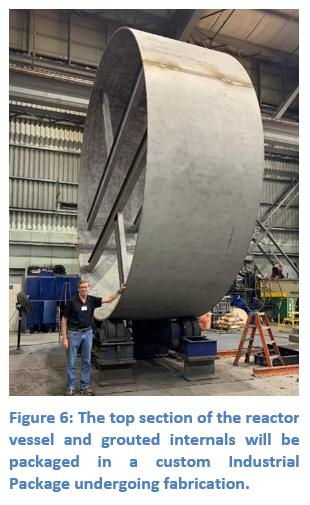 The reactor vessel closure head was removed from the top of the reactor vessel, stripped of its
control rod drive mechanisms and service structure, and packaged in a DOT-compliant (49 CFR 173) industrial package designed and procured by ODS. This component and package will be disposed of as Exempt waste.
The reactor vessel closure head was removed from the top of the reactor vessel, stripped of its
control rod drive mechanisms and service structure, and packaged in a DOT-compliant (49 CFR 173) industrial package designed and procured by ODS. This component and package will be disposed of as Exempt waste.
The RV/RVI top and bottom sections are classified as Class A and will be packaged in a DOT-compliant (49 CFR 173) industrial package designed and procured by ODS.
The RV/RVI middle section is the only segment which, once packaged, will constitute a Type B package containing Class C waste. This package is being designed by ODS and licensed by the NRC to comply with the requirements of 10 CFR Part 71.
The initial focus was on modifying the CR3 site infrastructure to reconfigure the facility so that it was ready to host dismantling activities and ship a large amount of waste off-site. This initial phase of the site work included, amongst many other activities, restoring site utilities, removing obsolete site equipment and structures, modifying the reactor building equipment hatch to facilitate a more efficient transfer of equipment and preparation of waste ready to be shipped, and extending the storage capacity of the existing ISFSI to receive the GTCC waste.
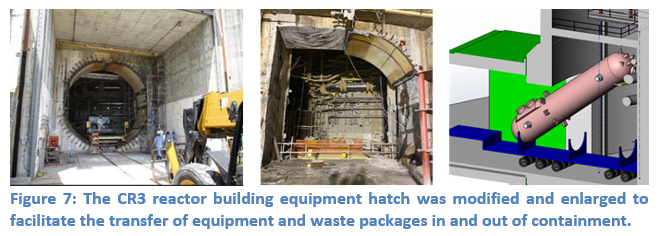
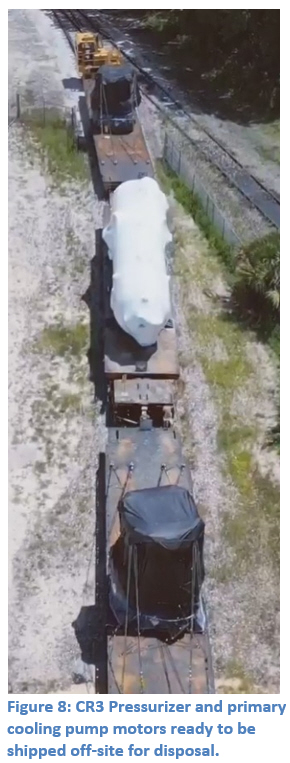 After just over a year into the contract,
the site modification and upgrades were completed, the reactor cooling system large components (steam generators, pumps, motors, the pressurizer, large bore piping) were removed, packaged, shipped off-site to Texas, and disposed of at the WCS facility.
After just over a year into the contract,
the site modification and upgrades were completed, the reactor cooling system large components (steam generators, pumps, motors, the pressurizer, large bore piping) were removed, packaged, shipped off-site to Texas, and disposed of at the WCS facility.
The reactor building was then reconfigured and setup with the reactor segmentation and packaging equipment. The fuel transfer canal was cleared of all obsolete equipment, prepared with floor protection plates, deep end and in-core instrumentation pit isolation gates, and a new working bridge with handling tools specifically designed for reactor segments. The deep end of the transfer canal was set up as an underwater segmentation workstation with segmentation tooling and water filtration systems. Preparations to initiate the RVI segmentation activities was completed on December 22, 2021.
The reactor head was removed from the vessel in January 2022. All control rod drive mechanisms (CRDM) were disassembled from the reactor head. The head service structure was removed from the head and size-reduced using thermal cutting.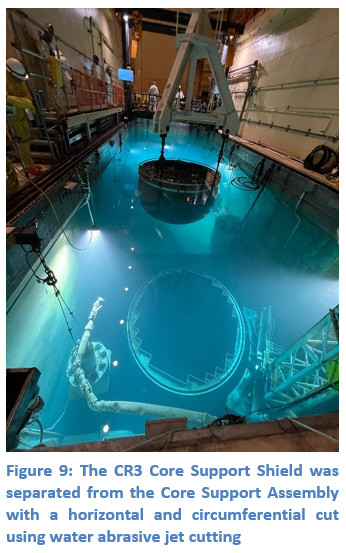 The CRDM and service structure components and segments were packaged, shipped off-site, and received and processed
for disposal at the WCS site in Texas by the end of February 2022.
The CRDM and service structure components and segments were packaged, shipped off-site, and received and processed
for disposal at the WCS site in Texas by the end of February 2022.
Work on the reactor internal structures started as soon as the reactor head was removed from the vessel and the transfer canal was flooded. The Plenum Assembly and Core Support Assembly were removed from the vessel and successively size-reduced to extract the GTCC components and to prepare the remaining RVI structures for repositioning inside the vessel per the Optimized Segmentation plan. The underwater RVI segmentation work was completed in November 2022. The consolidation of the remaining internals inside the reactor vessel and the packaging and transfer of the GTCC waste for storage on the CR3 Independent Spent Fuel Storage Installation is scheduled to be completed by the end of January 2023.
The balance of the work to drain down the transfer canal, immobilize the internal structures inside the vessel, cut the vessel and internals to generate the three large segments, and package and ship all Class A, B, and C reactor waste will be completed by the end of 2023.
ODS applied its patented Optimized Segmentation strategy to plan for the removal, packaging, off-site transportation or onsite transfer, and disposal or onsite storage of all the reactor vessel and internals components in a total of only two Class A industrial type large containers, one Class C Type B large container, and two GTCC Rad Waste Canisters (excluding the head and the secondary waste).
This packaging plan and large container strategy is significantly reducing the amount of segmentation work to be performed on the reactor structures, accelerating progress towards their removal from the containment building, and supporting the completion of the CR3 D&D program well within the six-year contract schedule.
The benefits of the Optimized Segmentation strategy include lower risk to workers during the significantly reduced onsite operations and to the public during the significantly reduced transportation frequency. Traditional segmentation typically requires more than 80 individual shipments of highly activated waste through the public transit system to the disposal site. Optimized segmentation requires only three shipments for the highly activated reactor components. ODS considers Optimized Segmentation a significant evolution in decommissioning strategy that optimally reduces the risk to the worker and public, the decommissioning fund expenditures, and the time required to achieve site release.
Sebastien Guillot, Matt Lucas, Dirk Bender
Orano Decommissioning Services, LLC
PRESENTED
March 1, 2023
Waste Management Symposia
ABSTRACT
Orano DS patented and is implementing at the Crystal River Unit 3 (CR3) accelerated decommissioning project in Florida an innovative approach to the dismantling of commercial and research nuclear reactors. The patented 1 Optimized Segmentation process aims to reduce the volume of waste for disposal and the amount of segmentation work on the reactor structures, with substantial benefits in overall execution schedule, dose, and cost.
At CR3, Optimized Segmentation avoids entirely the time-consuming segmentation and packaging into standardized waste containers (and their numerous waste shipments) of all non-GTCC-rated internals and the reactor vessel.
 The Optimized Segmentation process first segments, extracts and separates underwater all of the reactor internals into two categories:
1.) Greater-than-Class C (GTCC) waste to be handled, packaged, and stored using conventional methods (e.g.,
NUHOMS® systems); and 2.) highly
contaminated and activated internal structures.
The Optimized Segmentation process first segments, extracts and separates underwater all of the reactor internals into two categories:
1.) Greater-than-Class C (GTCC) waste to be handled, packaged, and stored using conventional methods (e.g.,
NUHOMS® systems); and 2.) highly
contaminated and activated internal structures.
The now-empty reactor vessel is repacked underwater using a precisely engineered placement of the highly contaminated and activated waste based on each piece’s characterization. This concentrates the highest waste category components in the middle of the vertical vessel, while less activated waste is placed in the bottom and top sections. The reactor vessel and repackaged internals are then drained and immobilized in grout specifically prepared to achieve the ALARA goal and to immobilize the reactor internals inside the vessel.
The solid, grout-filled reactor vessel packed with waste is subsequently segmented into three large sections (bottom, middle, top), consistent with the optimized waste distribution. Each section is packaged and shipped individually in a tailor-made container designed to safely transport and dispose of the waste in compliance with relevant regulations (NRC for Type B shipment, DOT for Industrial Package), and the disposal site’s Waste Acceptance Criteria.
Of the three segmented reactor vessel sections, only the middle section requires an NRC-approved Type B package for shipment in accordance with 10 CFR Part 71. The design of this Type B package was completed in August of 2021, and the license application is being reviewed by the NRC. The optimized waste characteristics in the two remaining reactor vessel segments – the bottom and top sections – will only require shipping containers to comply with the DOT Industrial Package regulations (49 CFR 173).
Reactor dismantling operations started at CR3 in 2021. Components of the reactor cooling system (Steam Generators, Main Coolant Pumps & Motors, the Pressurizer, and Large Bore Piping) have been removed from the containment building and shipped off-site for disposal. Segmentation of the reactor internals at CR3 commenced and were completed in 2022 and removal of all reactor structures from the containment building will be completed in 2023.
1 Orano DS holds U.S. patents (US 9,728,287 and US 9,984,780) for a method of decommissioning a nuclear reactor that is referred in this publication as “Optimized Segmentation”.
1. Introduction: Orano Decommissioning Services and the Crystal River Nuclear Plant Decontamination and Dismantlement
Orano USA is a major nuclear supplier of materials and services with in-house capabilities and decades of experience in used nuclear fuel management, decommissioning and dismantling, and packaging and transporting radioactive materials. The company has some of the most advanced reactor vessel segmentation specialty tools and equipment in the industry.Orano DS LLC (ODS) and TN Americas (TN), as two of Orano USA’s business units, provide expertise throughout the entire decommissioning process for U.S. facilities, including planning, engineering, project management, used fuel transfer from wet to dry storage, decontamination, dismantling, waste packaging and transport, ISFSI management, used fuel transport offsite, and site restoration.
 Accelerated Decommissioning Partners (ADP) is a joint venture formed in 2017 between NorthStar Group Services, the
largest demolition company in the world, and Orano USA. ADP delivers a unique offer adapted to best fit the needs of shutdown reactor owners and provides an accelerated turnkey solution that completes the Nuclear Regulatory Commission license termination
process for a fixed price on a guaranteed schedule.
Accelerated Decommissioning Partners (ADP) is a joint venture formed in 2017 between NorthStar Group Services, the
largest demolition company in the world, and Orano USA. ADP delivers a unique offer adapted to best fit the needs of shutdown reactor owners and provides an accelerated turnkey solution that completes the Nuclear Regulatory Commission license termination
process for a fixed price on a guaranteed schedule.
The ADP member companies, NorthStar and Orano, are performing the decommissioning of Vermont Yankee (VY), which was also the industry’s first complete and permanent license transfer of a shutdown reactor from a utility to a private entity, NorthStar, for decommissioning. As the leading global demolition company and now as the VY site owner, NorthStar is efficiently managing and performing the complex requirements of a safe, efficient, and compliant accelerated decommissioning project. As a subcontractor on the NorthStar team, Orano applied its global expertise to segment and package the reactor vessel and its internal structures, and safely transport some of the highest activity components to the disposal site in Texas. Orano completed the segmentation and disposal of the reactor and its internal components in August 2022, less than five years after the accelerated decommissioning began, with no safety or regulatory issues.
 On Oct. 1, 2020, Accelerated Decommissioning Partners and Duke Energy completed a transaction to begin decontamination and dismantlement of the Crystal River Nuclear Plant (CR3) in Citrus County, Fla., in 2020 instead of 2067
– nearly 50 years sooner than originally planned. Accelerated Decommissioning Partners became the Nuclear Regulatory Commission-licensed operator responsible for decommissioning the plant, and acquired the used nuclear fuel and the ISFSI assets
where it is stored, in compliance with all state and federal regulations.
On Oct. 1, 2020, Accelerated Decommissioning Partners and Duke Energy completed a transaction to begin decontamination and dismantlement of the Crystal River Nuclear Plant (CR3) in Citrus County, Fla., in 2020 instead of 2067
– nearly 50 years sooner than originally planned. Accelerated Decommissioning Partners became the Nuclear Regulatory Commission-licensed operator responsible for decommissioning the plant, and acquired the used nuclear fuel and the ISFSI assets
where it is stored, in compliance with all state and federal regulations.
ODS supports the CR3 work focusing on the dismantlement of the Reactor Cooling System, Vessel, and Vessel Internals.
After just one year, all major components of the Reactor Cooling System have been removed, packaged, shipped off-site by rail, and disposed of at the Waste Control Specialist waste disposal facility in Andrews, Texas. At the same time, ADP CR3 and ODS had reconfigured the CR3 Reactor Building and completed preparations to begin the disassembly and dismantlement of the reactor components.
2. Context and objective of ODS’ optimized segmentation strategy: continue to develop and deliver safe and cost-effective solutions to accelerate nuclear reactor decommissioning
ODS has been growing its experience and expertise in reactor D&D through the successful completion of multiple projects in Europe and the U.S., with a focus to take advantage of the state-of-the-art in all available technologies, to continuously improve the reactor components segmentation strategies and processes, and to ultimately offer solutions that reduce the cost and timeline for completion.The main drivers in the cost and schedule of a reactor D&D operation are typically the extent of segmentation work to be performed on the reactor component and the number, size, and classification of the waste packages generated by the dismantling process.
The most contaminated and activated components of a nuclear energy reactor are concentrated inside the reactor vessel (RV) and vessel internal structures (RVI). The dismantlement of the RV and RVI structures generates the waste with the highest classifications: A, B, C, and Greater-than-Class C (GTCC), and the highest cost for packaging, transportation, and ultimately disposal.
Optimizing cost involves being able to segregate and distribute the generated waste within the various classifications in an effort to minimize the volume of the most costly portion of the waste: GTCC and Class B/C.
The art of planning the segmentation and packaging of the RV and RVI waste involves finding the ideal compromise working within the following constraints:
- Capabilities and limitations of the segmentation technologies available to perform the separation and size reduction of highly radioactive reactor components. Because of the complex environment in which the segmentation equipment is used, and the
highly radioactive nature of the components to be segmented, the segmentation work is labor-intensive and time-consuming.
- Capacities in weight and volume of the existing packaging systems licensed to receive and store and/or transport the generated waste in each category, driving the maximum size of the segments generated in each category. The high cost of procuring, transporting, and disposal or storage of the waste containers encourages achieving the highest packaging efficiency, which drives towards more extensive segmentation of the reactor components.
One solution to this challenge is the “one piece” approach, where the entire reactor vessel is shipped, including some of the reactor vessel internals. This solution has been successfully implemented in previous reactor D&D projects (Trojan, Yankee Rowe, Songs Unit 1), but involves very large packages and conveyance systems, which will be constrained by the limitations of the available transportation route infrastructure (roads and bridges capacities, clearance limitations from other overhead structures such as bridges, tunnels, power lines, etc.).
The waste generated during the D&D of CR3 is being shipped from Florida to Texas and disposed of at the Waste Control Specialists (WCS) facility in Andrews, TX. The location of CR3 offers access to transportation by road, rail, and barge through the Gulf of Mexico. The barging option offers the opportunity to ship large containers all the way to Texas, but the transit from the coast of Texas to the WCS facility still imposes the limitations of a long road and/or rail transportation. ODS, with support from its transportation logistics sister division TN Americas, conducted a route survey to determine that a combination of barging and road transportation offered the opportunity to ship packages as large as 18 feet high, 20 feet wide, and with a load of up to 450 Metric Tons without necessitating temporary cost-prohibitive road infrastructure modifications.
This envelope formed the basis of the Optimized Segmentation strategy implemented for CR3.
3. The CR3 Optimized Segmentation
3.1 CR3 reactor components waste classification The Crystal River Unit 3 nuclear power plant is a Babcock and Wilcox Pressurized Water Reactor which operated for more than 40 years before ceasing operations in 2009.
The Crystal River Unit 3 nuclear power plant is a Babcock and Wilcox Pressurized Water Reactor which operated for more than 40 years before ceasing operations in 2009.
ODS modeled the operating history of the reactor, calculated and analyzed how the various components of the reactor had been irradiated and activated, and, using survey data, was able to predict the expected waste classification of each part of the reactor vessel and internals.
The CR3 RV/RVI Greater-than-Class C components are located in the core region internals and consist of the core barrel assembly, the surveillance capsule holders, surveillance capsule dosimeters, and in-core instrument detectors. These components were separated and segregated from the rest of the RV/RVI components and packaged in containers to be transferred and stored on site within the existing CR3 Independent Spent Fuel Storage Installation (ISFSI).
The CR3 RV/RVI Class B/C components are located in the other areas closest to the core region and consist of the control rod guide tube assemblies, upper core grid, the thermal shield, and lower internals assembly.
The CR3 Class A and B/C will be segmented and packaged for off-site shipment and disposal at the WCS disposal facility using the Optimized Segmentation approach.
The CR3 RV/RVI Class A components are the balance of RV/RVI components, the plenum cover, plenum cylinder, core support shield assembly, reactor vessel, and vessel head.
3.2 CR3 segmentation and packaging strategy
 The shipping container envelope set as the basis for packaging the CR3 Class A, B and C waste offers the possibility
to package the entire vessel and internals in three segments or slices, using the vessel as a primary shell, along with handling the reactor head separately as one piece.
The shipping container envelope set as the basis for packaging the CR3 Class A, B and C waste offers the possibility
to package the entire vessel and internals in three segments or slices, using the vessel as a primary shell, along with handling the reactor head separately as one piece.
Once the GTCC portion of the internals has been extracted, the balance of the internal structures are separated, segregated, recombined, and positioned inside the vessel. The segmentation and segregation plan of the internals enables the concentration of the Class B and C components within the volume of one large shipping container, created out of the middle section of the vessel, with both the remaining top and bottom sections containing only Class A waste.
Once the internal structure segments have been recombined inside the vessel, a specifically engineered grout is used to immobilize the various components and diamond wire sawing is used to separate the vessel monolith into three horizontal sections.
3.3 CR3 segmentation and packaging process and technologies
3.3.1 Reactor Vessel Closure Head
The CR3 reactor head is a Class A component which will be handled, packaged, shipped, and disposed of as one piece, once the control rod drive mechanisms and service structure have been removed. Because of its very low level of activation and contamination, the reactor head was packaged into a custom-designed super sack.
3.3.2 CR3 GTCC waste segregation, packaging, and onsite storage
The GTCC portion of the reactor vessel internals is located on the Core Support Assembly (CSA).
First the plenum assembly is unloaded from the vessel and its top portion is modified so it can be reloaded later inside the vessel at a lower altitude without hanging from the vessel top flange.
The CSA will be unloaded from the reactor vessel and transferred into the deep end of the Fuel Transfer Canal where a segmentation workstation has been setup. The main segmentation technology selected for this application is the Water Abrasive Suspension System (WASS).
The WASS technology offers the ability to perform precise, remotely controlled cuts through several inches of the combination of steel/water/steel, as encountered on the core barrel and core baffle plates assembly, thus minimizing the number of cuts and segments to be handled.
WASS is first used to modify and separate the core support shield from the rest of the CSA and remove the thermal shield in several segments. The core barrel assembly (core barrel, former plates, and baffle plates) is then segmented in 16 vertical strips, sized to fit into two TN NUHOMS® Rad Waste Canisters (RWC).
The two RWCs are then closed, sealed by welding, and transferred for onsite storage on the existing CR3 ISFSI, using the TN Americas’ OS-197 transfer cask system.

3.3.3 Consolidation of the non-GTCC waste inside the reactor vessel
The remaining bottom section of the core support assembly, including the lower grid and flow distribution structures, is repositioned inside the reactor vessel as one piece without any additional segmentation work.
The segments of the thermal shield are loaded inside the vessel and positioned on top of the lower internals. These segments include the surveillance specimen holder tubes. The tightly packed pieces in the lower section prevent the highly activated components in the middle from sliding down into the lower section before grouting.
The plenum assembly, including all the control rod guide tubes, is loaded back into the core support shield. Both components are then positioned in the upper section of the vessel on top of the lower core assembly and thermal shield segments. The overall altitude/vertical position of these stacked RVI structures is set such that the Class B and C components are located in the middle section of the reactor vessel. This completes the underwater portion of the segmentation work and the fuel transfer canal and vessel can now be drained down.
The segments of the internals positioned inside the vessel are immobilized in engineered grout through several successive placements. Once the grout has solidified, the vessel nozzles are severed so that the vessel is separated from the reactor cooling system piping. Then, the vessel insulation is removed.
3.3.4 Segmentation, packaging, and off-site shipment of the vessel and internals
Diamond wire sawing will be used to perform controlled horizontal cuts through the section of the vessel and grouted internal structures to separate the vessel monolith into three horizontal slices sized to fit within the dimensional and weight constraints of the transport packages.
A heavy lifting and rigging system will be setup inside the containment building to complement the limited load capacity of the CR3 overhead crane and transfer the RV/RVI segments from the reactor cavity to the equipment transfer hatch.
 The equipment transfer hatch has been modified with a larger floor level opening and a reinforced
floor loading capacity to enable direct access and loading of the segments inside the packages.
The equipment transfer hatch has been modified with a larger floor level opening and a reinforced
floor loading capacity to enable direct access and loading of the segments inside the packages.
 The reactor vessel closure head was removed from the top of the reactor vessel, stripped of its
control rod drive mechanisms and service structure, and packaged in a DOT-compliant (49 CFR 173) industrial package designed and procured by ODS. This component and package will be disposed of as Exempt waste.
The reactor vessel closure head was removed from the top of the reactor vessel, stripped of its
control rod drive mechanisms and service structure, and packaged in a DOT-compliant (49 CFR 173) industrial package designed and procured by ODS. This component and package will be disposed of as Exempt waste.
The RV/RVI top and bottom sections are classified as Class A and will be packaged in a DOT-compliant (49 CFR 173) industrial package designed and procured by ODS.
The RV/RVI middle section is the only segment which, once packaged, will constitute a Type B package containing Class C waste. This package is being designed by ODS and licensed by the NRC to comply with the requirements of 10 CFR Part 71.
4. CR3 Dismantlement Progress To Date (December 2022)
Upon the closure of the Crystal River Nuclear Plant Decontamination and Dismantlement contract between Accelerated Decommissioning Partners and Duke Energy on October 1, 2020, ODS immediately initiated its planning and site mobilization efforts.The initial focus was on modifying the CR3 site infrastructure to reconfigure the facility so that it was ready to host dismantling activities and ship a large amount of waste off-site. This initial phase of the site work included, amongst many other activities, restoring site utilities, removing obsolete site equipment and structures, modifying the reactor building equipment hatch to facilitate a more efficient transfer of equipment and preparation of waste ready to be shipped, and extending the storage capacity of the existing ISFSI to receive the GTCC waste.

 After just over a year into the contract,
the site modification and upgrades were completed, the reactor cooling system large components (steam generators, pumps, motors, the pressurizer, large bore piping) were removed, packaged, shipped off-site to Texas, and disposed of at the WCS facility.
After just over a year into the contract,
the site modification and upgrades were completed, the reactor cooling system large components (steam generators, pumps, motors, the pressurizer, large bore piping) were removed, packaged, shipped off-site to Texas, and disposed of at the WCS facility.
The reactor building was then reconfigured and setup with the reactor segmentation and packaging equipment. The fuel transfer canal was cleared of all obsolete equipment, prepared with floor protection plates, deep end and in-core instrumentation pit isolation gates, and a new working bridge with handling tools specifically designed for reactor segments. The deep end of the transfer canal was set up as an underwater segmentation workstation with segmentation tooling and water filtration systems. Preparations to initiate the RVI segmentation activities was completed on December 22, 2021.
The reactor head was removed from the vessel in January 2022. All control rod drive mechanisms (CRDM) were disassembled from the reactor head. The head service structure was removed from the head and size-reduced using thermal cutting.
 The CRDM and service structure components and segments were packaged, shipped off-site, and received and processed
for disposal at the WCS site in Texas by the end of February 2022.
The CRDM and service structure components and segments were packaged, shipped off-site, and received and processed
for disposal at the WCS site in Texas by the end of February 2022.
Work on the reactor internal structures started as soon as the reactor head was removed from the vessel and the transfer canal was flooded. The Plenum Assembly and Core Support Assembly were removed from the vessel and successively size-reduced to extract the GTCC components and to prepare the remaining RVI structures for repositioning inside the vessel per the Optimized Segmentation plan. The underwater RVI segmentation work was completed in November 2022. The consolidation of the remaining internals inside the reactor vessel and the packaging and transfer of the GTCC waste for storage on the CR3 Independent Spent Fuel Storage Installation is scheduled to be completed by the end of January 2023.
The balance of the work to drain down the transfer canal, immobilize the internal structures inside the vessel, cut the vessel and internals to generate the three large segments, and package and ship all Class A, B, and C reactor waste will be completed by the end of 2023.
5. Conclusion
After just over two years since the CR3 contract was initiated, ADP CR3 and ODS have made significant progress in the dismantlement of the CR3 Nuclear Power Plant.ODS applied its patented Optimized Segmentation strategy to plan for the removal, packaging, off-site transportation or onsite transfer, and disposal or onsite storage of all the reactor vessel and internals components in a total of only two Class A industrial type large containers, one Class C Type B large container, and two GTCC Rad Waste Canisters (excluding the head and the secondary waste).
This packaging plan and large container strategy is significantly reducing the amount of segmentation work to be performed on the reactor structures, accelerating progress towards their removal from the containment building, and supporting the completion of the CR3 D&D program well within the six-year contract schedule.
The benefits of the Optimized Segmentation strategy include lower risk to workers during the significantly reduced onsite operations and to the public during the significantly reduced transportation frequency. Traditional segmentation typically requires more than 80 individual shipments of highly activated waste through the public transit system to the disposal site. Optimized segmentation requires only three shipments for the highly activated reactor components. ODS considers Optimized Segmentation a significant evolution in decommissioning strategy that optimally reduces the risk to the worker and public, the decommissioning fund expenditures, and the time required to achieve site release.
RESOURCES
Crystal River 3 website>> Return to Orano White Papers
